TIFF50: Best of Wavelengths and Strange Cuts
- Brandon MacMurray
- Sep 19
- 11 min read
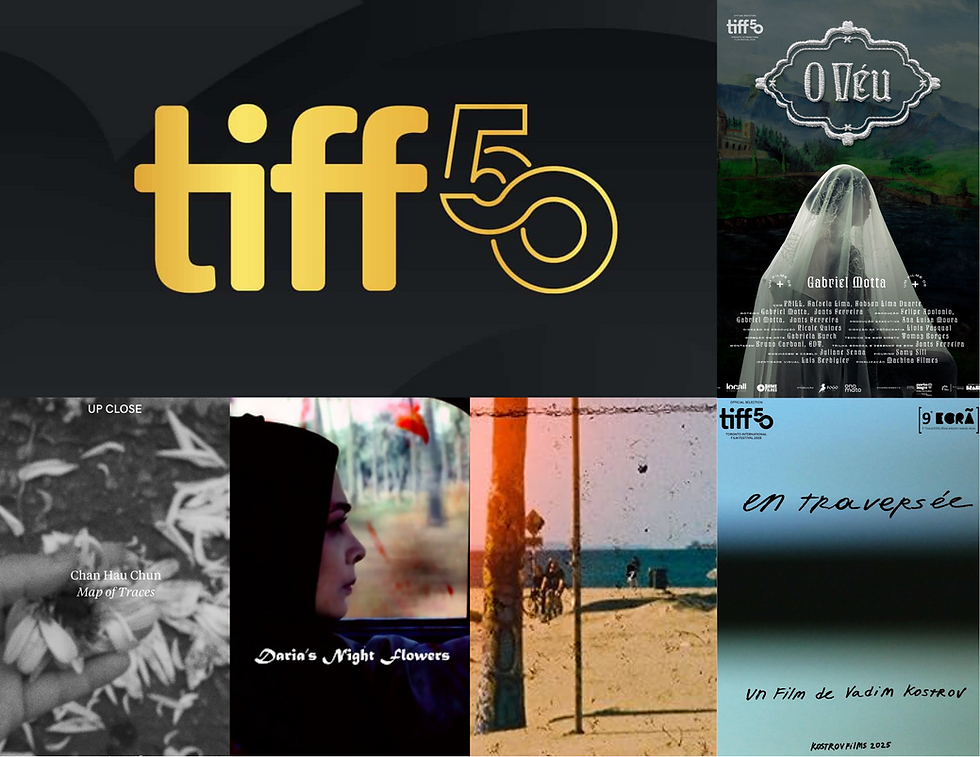
Here at ShortStick we like to leave no stone unturned, exploring every genre of short film, including experimental shorts and some of the stranger corners of short film. Some of the best work in short film can be found in more experimental blocks that TIFF offers like Wavelengths and Strange Cuts. We are lucky to have writers on this site like Josh and Pedro who are passionate about this unique style of film-making. Here they write about five of their favourites from these blocks at TIFF.
O Véu (The Veil), dir. Gabriel Motta

Gabriel Motta is one of the most talented Brazilian directors in the recent history of local cinema. In 2024, he premiered Pastrana at the Tribeca Film Festival, which he co-directed with Melissa Brogni, and it was at two of the most prestigious national festivals: Gramado and Brasília. Motta is back on the international festival scene with his latest film: O Véu (The Veil). The young director shifts from a poetic documentary about grief in the sports universe to the supernatural in the faux prophets' world. He narrates the story of a family of three: Ismael (Robson Lima Duarte), the pastor, Ismael Jr. (Phill), the miracle man, and Rebeca (Rafaela Lima), the church's assistant. These three organize worship services where they pretend to listen to messages from deceased loved ones of the individuals in the services. After an incident in one of those worship services, everything changes at the church.
Consequently, the director studies the supernatural forces that suddenly interfere in the family's business. First of all, the film takes place in two central scenarios: the church and the home. In this sense, the production design creates props that employ an allegorical and horrific milieu in the film. The title object, a lace veil, is the vehicle for the miraculous communication between the pastor's son and the unliving. Yet, Motta utilizes this veil of lies to symbolize the result of their wrongdoings, when it covers the outcome of the incident. The same object symbolizes life and death, and the director graphically implies this through a tense scene of human despair and guilt. Besides the obvious violent disposal, the detailed frame of the eyes of Rafaela Lima showcases a true horror spectacle, brought on by the necessity of lying and profiting off of someone else's faith.
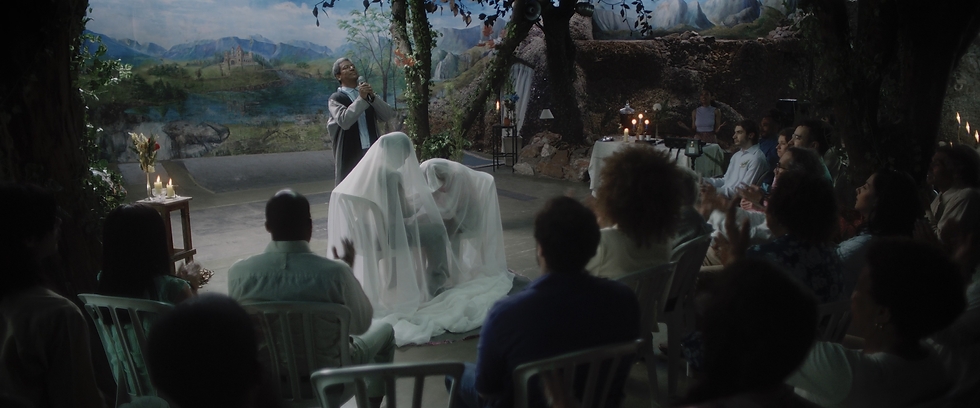
Motta decides to invest in atmospheric tension. Firstly, at the incident, and later on, a supernatural possession. Consequently, the theme analyzes the accelerated expansion of the Pentecostal community in the country, which often initiates the debate about the slim line between church profits and providing a venue for God. In a country where all religious institutions receive a government waiver of income tax, a myriad of churches found a business model. Similar to a franchise chain, they spread throughout the country, gathering the support of those who seek God. The director finds in horror conventions the accurate tools to criticize a practice that happens in a few of the country's churches. Thus, the veil, the candles, and the ambient music are mechanisms of a faux spiritual moment. They represent the greed of a spiritual leader, focusing on the theatricality of what he believes is faith, while practicing his prejudices and intolerances.
Hence, Gabriel Motta invests in analyzing Brazil's problems through a genre lens. He uses the supernatural to delve into the contradictions and hypocrisy of the religious leaders, the faces of the institutions. Rafaela Lima delivers a stellar performance, portraying a third-party element that becomes central to the exposition of the scheme. In O Véu (The Veil), the director utilizes the lace veil as a mirror to the wrongdoings of faith.
Review by: Pedro Lima
Map of Traces, dir. Chan Hau Chun

“Moments together leave me with a subtle sense of disorientation”
Map of Traces is filmmaker Chan Hau Chun’s attempt to navigate the border between personal and collective memory of the past and the possible futures of her native Hong Kong. Organized roughly into three parts, a figurative and literal trip down memory lane, a look into current local public life, and correspondence with an imprisoned acquaintance, the film is dense with fleeting recollections and ephemeral encounters. “Memory is hidden, waiting for the right moment to resurface,” Chun says in voiceover. Map of Traces is Chun choosing the present to be that moment.
Chun begins her excavation of the past by browsing her Hong Kong neighbourhood on Google Street View, reminiscing with a friend in London about their time on Nathan Road. The features inherent in Google’s anonymization blur out the faces of the people lining the street, making the image into a memory that’s not quite there, details obscured and hidden by faulty memory, lost to the nostalgia of the past. Hong Kong used to be her home, and though the map is updated regularly, what they see never changes—she sighs as she zooms in on a group of old men still playing chess by the side of the road.

When Chun moves from place to place in Street View, motion blur obfuscates the sights as it moves, as if remembering important landmarks but not the “in-betweens,” the liminal spaces of roads, parks, sidewalks lost to nostalgia. Chun’s relocation from Hong Kong to London is less about living in a new country, but about living in the current era, trying to figure out how to live in this time and place. “The banyan trees should be there forever, right?” she wonders as the mouse makes the camera pan up through the leaves of the Hong Kong trees, “I haven’t seen any banyan trees here in the UK.” Her sense of security has fallen apart, and she is desperate to find meaning.
Inherent in the idea of a “trace” is the absence of something which was once there, as well as the act of searching for and discovering the evidence of what was lost. It is these fragile particles of memory that became displaced in Chun’s move from Hong Kong to London that are being searched for; their locations and meaning both precise and slippery, and found somewhere between presence and absence. Chun presents her mediated memory in a glistening black and white, which gives it a feeling of “past,” even when focused on the present, or wondering about the future. The ephemerality of maps, surveillance camera, letters, and handwritten notes (“I’m your forgotten memory,” reads one note tucked into a plant) which constitute the film only exaggerate the strange sense of dislocated time and space.
The landscape of Hong Kong itself is not just a backdrop to Chun’s story but is a fragmented site of entanglement between memory, ideology, and power. In Map of Traces, Chun looked back at the city from the temporal and geographic remove of diaspora. Both memories and futures have countless versions—Chun’s wistful “I don’t even know if I’ll ever walk this road again” leaves the future open to any possibility.
Review by: Joshua Hunt
Daria’s Night Flowers, dir. Maryam Tafakory
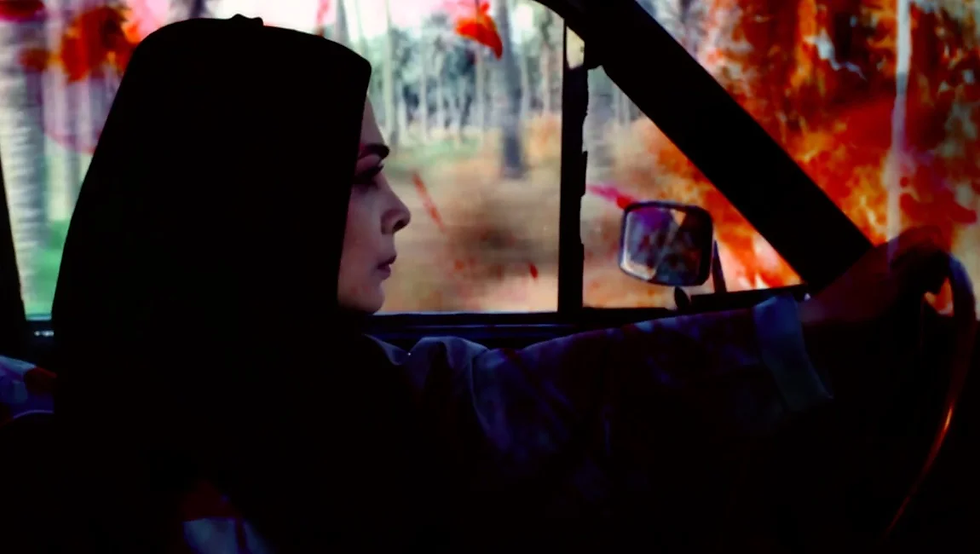
In her research into post-revolution Iranian cinema, Maryam Tafakory found a plethora of scenes of women taking sedatives or attempting to end their lives with medication. Using this as her starting point, she sourced a collection of clips from films where women are denied agency over their lives, but in her new short film Daria’s Night Flowers, she reimagines this tragic scenario as a story of queer love, vengeance and survival. In Iran, officially, lesbians do not exist, and censorship has ravaged the film community. Filmmakers working under this regime must leave things unsaid or hidden as subtext. Tafakory has chosen instead to make the subtext text.
Born and raised in Iran, Tafakory is a visual artist who makes textual and filmic collages that bring together poetry, speculative nonfiction, and archival material. Due to censorship laws, Iranian films are legally unable to present queer sexuality; in her last several films (including 2022’s Nazarbazi and 2023’s Mast-Del) Tafakory has used clips from Iranian films to create an impossible cinema, where queer desire is possible. Her research-based projects consider what is often neglected and discarded as trivial or excessive, looking at historical gaps, unspoken rules, and concealed queer stories.
Tafakory consciously stays away from narratives that dominate Iranian post-revolutionary cinema, the brutalization of woman who are stuck at a dead-end and the whims of the men around them. Daria’s Night Flowers, instead is about disappearing and escape and is largely focused on the sensations delivered by its assemblage of film history, but Tafakory does massage the clips into a plot. “The first time Daria disappeared it was an accident… the second time it was not,” whispers a female narrator in a quietly delivered voiceover. Daria was arrested by the state, four days after she sent the final chapter of her manuscript to her friend Roya asking for it to be buried. The handwritten novel is about falling in love with a girl called “Blue.” Daria’s husband could not accept the manuscript it as fiction, and he set the pages on fire one by one.
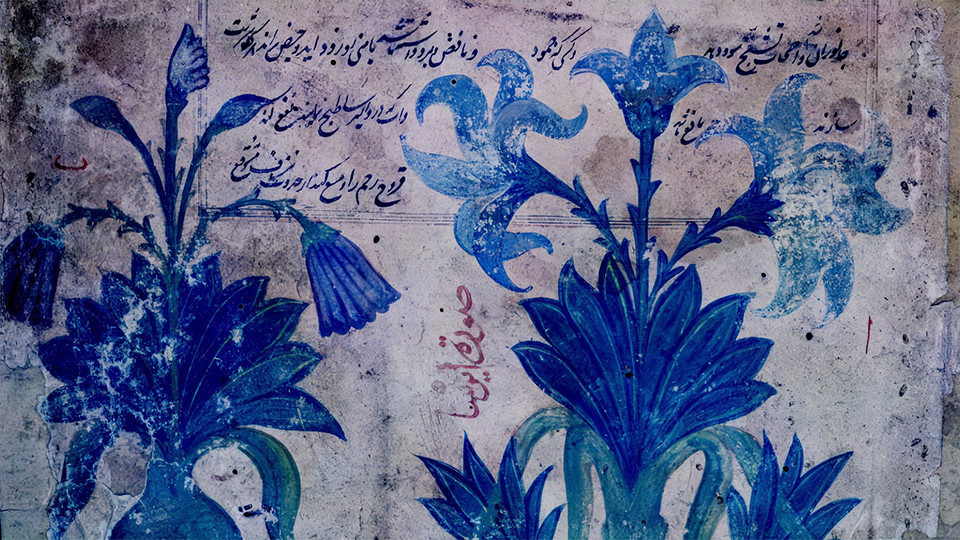
Daria’s obsession is mirrored on screen in its shots of blue blue blue. Rippling blue waters are superimposed on top of bright sun catchers, and blossoming flowers, blue dyes even spill across the screen. Daria’s love for Blue is all she has; she is against her husband, family tradition, the regime, the real police and the fake police made up of her father, brother, uncles, and the women who agree with the men. Their solution for Daria is a prescription for conversion therapy to treat hysteria and sexual perversion. Rather than withstand the “gentle beatings of a handsome man,” Daria’s solution is plants that can heal and kill at once, Sister of Nepenthes to induce forgetfulness and Belladonna Nightshade, which can lead to delirium, hallucination, paralysis and death: the remedy for the pain of loving the one you mustn’t.
Daria’s Night Flowers creates an enthralling portrait of love and desire in Iranian cinema where depictions of intimacy are prohibited. Tafakory makes use of blurred-out blue filters and nature sounds, creating a pastoral beauty despite the ugliness of the repression in the story. Double exposures, superimpositions, on-screen handwriting, photos, book pages, and paintings cascade across the screen making Daria’s Night Flowers never less than enthralling to look at, its vibrant colours like one beautiful cyanotype after another.
In a country that has turned love stories into crime scenes, a small number of filmmakers are working to tell hidden stories to a wider public. Iranian law labels women as “insane” and makes room for state-sanctioned murder of women and queers whose desires exceed what is legally permitted. Tafakory is angry but Daria’s Night Flowers never rises above a whisper, it keeps its rage secret.
Review by: Joshua Hunt
En Traversée, dir. Vadim Kostrov
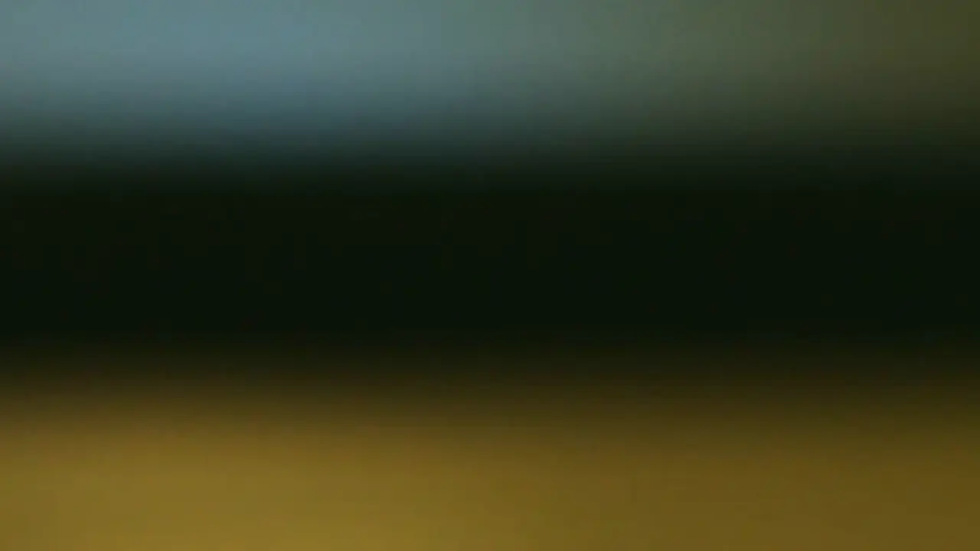
Shot onboard a train journey from Paris to Rouen in early January 2025, prolific young Russian-born director Vadim Kostrov’s enigmatic new short film En Traversée brilliantly captures the feeling of being in transition and discovering new places, through colours, movement and impressions along the way. Created as a series of painterly applications of blurred-out colour fields with indistinct edges, the Rothko-esque tableaux of abstract expressionism make a fascinating travelogue out the basest elements of filmmaking: motion, picture.
Cinema has a rich history of train films, from The General and Shanghai Express to The Darjeeling Limited and Snowpiercer, but En Traversée’s closest analogue might be Michel Gondry’s Star Guitar, with its window-facing camera and inventively rhythmic editing. Kostrov’s view, too, never movies from the train window, the passing sights becoming impressionistic patterns of movement and colour, light and shadow. Details flicker by the train window, of blurry horizons, distant forests, but above all En Traversée is about movement and colour.
Shot on Kostrov’s trusty MiniDV camera, En Traversée has the grainy look and faded textures of early-2000s home video, which inherently transforms the film into a poetic tool for memory where everyday encounters become part of a lyrical structure where time and meaning emerge slowly. The result is not a record of life as it is, but something between figurative and abstract, a space of memory and transformation, immersing viewers into the film, bringing us new impressions of the space in between, between reflections, between physical and spiritual.

Kostrov has left his native Russia in 2022 in protest of the war in Ukraine and has moved his slow-cinema storytelling to his new home in Paris. His life in exile means that Kostrov is always travelling, creating cinema as he moves. Rather than documenting the everyday, Kostrov integrates memory and fiction to construct emotionally charged scenes of presence—creating impressions of people, gestures, and places that in Kostrov’s camera because almost like reveries, or intimate reflections.
The indistinct and undefined nature of Kostrov’s train-window photography means that he is creating an image without an inherent meaning. While taking in the totally silent pictures, each viewer may assign a different meaning to the images; maybe reminiscing about a train trip of their own or finding totally unrelated inspiration in the film’s abstract expressionism. En Traversée ends up as an investigation into each viewers memory and nostalgia, a window looking onto a world in motion acting as a lens into the past.
En Traversée creates a triangular relationship between the camera, time, and nature. Near the end of the film, a silhouette of a face appears in the reflection of the train window, the first human image and the only time in which actual details can be made out, bringing the viewer back into the present, onboard the moving train. In creating En Traversée, Kostrov has made a poetry of displacement that mirrors his life in exile, always moving, looking, searching.
Review by: Joshua Hunt
I Saw the Face of God in the Jetwash, dir. Mark Jenkin
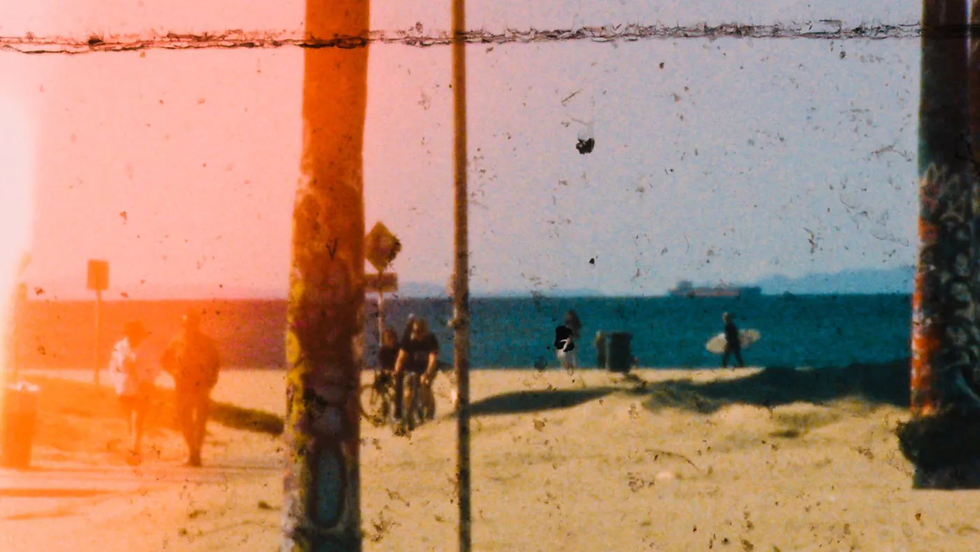
The British director Mark Jenkin is a constant presence in the experimental filmmaking circuit. Since his debut feature, Bait, the director has been at the world's principal film events. The first film premiered at the Berlinale, his sophomore film, Enys Men, at the Cannes Film Festival, and his latest, Rose of Nevada, at the Venice Film Festival. Solely in three features, Jenkin has been to all three main festivals in the world. However, during the three years that separated each film, the filmmaker shot his travels around England and the world while presenting his films. We can see this material in his new short, I Saw the Face of God in the Jetwash, which premiered at the Karlovy Vary Film Festival, a crucial event between Cannes and Venice.
Shot on Super 8, the director documents his routine as an independent filmmaker who survives on presenting his past work in festivals while brainstorming the next project. The crisp imagery of the film shows the passages that accompany his solitary journey. Jenkin observes the Anfield Stadium, home of Liverpool FC, from afar. Before the Liverpool scenes, he manipulates the color of his London footage, employing a lack of saturation in the film material. He narrates the short with a 1950s-sounding recording, alluding to the past reports from analog radio. Hence, the filmmaker evokes the past to document the present, constantly citing future ideas that converse with finished projects. Jenkin's narration is a testimony to the sleepless nights as a director, presenting his past work, while searching in the wild for the next one.
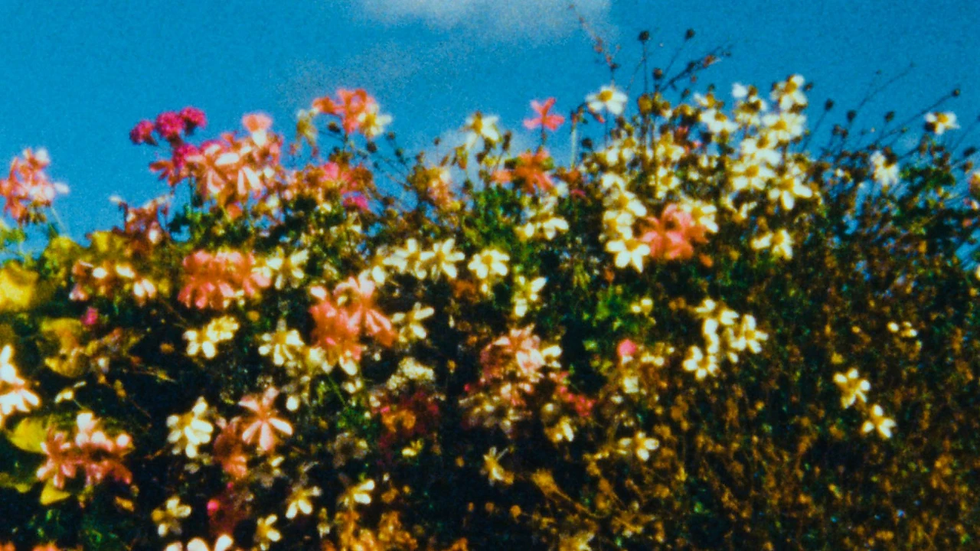
In that regard, the director's diary is proof of the cinephile's obsession, one who searches for film references in every corner of the world. Yet, Jenkin is an arts aficionado; he looks for James Joyce's descriptions of Dublin while wandering around the town. In the cinematic field, he gushes over the house where Alfred Hitchcock shot his classic Rebecca, mentioning production notes regarding that location. Therefore, Mark behaves like a child in the playground when he lands in Los Angeles, the land of the stars. He quickly commutes to Beverly Hills, searching for Mitch Buchannon's house in Baywatch. The director reflects millions of cinephiles, who connect their film obsessions with the world around them.
Besides the narration, the analog style is present in the visuals through the crispness and texture of the Super 8 film. The director pays homage to the past as he documents the touring of each of his works. These do not have a date where their tours will finish, but once they do they'll live forever in the film material. Mark Jenkin registers the loneliness of these world tours, filling the emotional gaps with comfort earned through cinema, a resource most cinephiles seek. Ultimately, it is a fascinating work due to its combination of an aesthetic from the past that clashes with the current film manufacture. Lately, the overworked aesthetic and a lack of visual care in digital cinematography have become the norm. In contrast to the current film production, Jenkin writes his diary through the low-frequency mic and the crisp Super 8, which provides a nostalgic visual to the exercise of searching for cinematic references in the world around us.
Review by: Pedro Lima




Comments